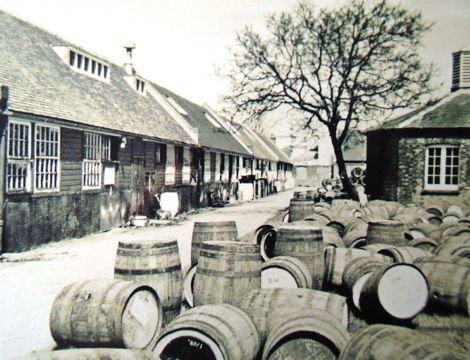Following on from our post yesterday about Queen Victoria’s connection to Royal Clarence Yard, today’s blog delves into Clarence Yard’s primary use for several hundred years as a victualling yard.
Feeding the navy has always been a big job, with huge quantities of ale, rum, meat, bread being produced along with many other provisions. Royal Clarence Victualling Yard embodies this years theme of Astounding Inventions perfectly as the newest technology available was always employed to ensure the most nutritious food could be produced in large quantities as it was important that the men of the navy got all the nutrients they needed to stay in tip top form.
Ship’s Biscuits
Ship’s biscuits also known as hard tack, due to their texture of a dog biscuit, were a vital part of naval diets prior to the introduction of food preservation techniques in the mid-nineteenth century. There are references to ship’s biscuits right back in 1190 when Richard I set off to Jerusalem with ships filled with ‘biskit of muslin’.
Within Royal Clarence Victualling Yard there was a designated granary and bakery to ensure enough biscuits to keep the navy fed could be produced. The granary was right on the edge of the wharf raised up on massive cast iron columns which made the unloading of grain into the building much easier. The biscuit making machinery managed by Thomas Tassell Grant, was described in 1832 as “highly interesting and the celerity with which it mixes flower and water, kneads the dough, rolls it into thin sheets and cuts it into biscuits, is truly marvellous.” The nine brick-lined ovens in the bakery were extremely efficient, able to bake ten thousand hexagonal biscuits an hour!
Preserving Food
For centuries before the introduction of canning procedures, all food and drink consumed on board ships was packed into wooden barrels in order to keep food safe from contamination during voyages. During the eighteenth century and prior, the diet of sailors mainly consisted of ship’s biscuits, cheese and peas which all had low contamination risk as well as meat and fish which was heavily salted and dried as a method of preservation.
The cooperage in Clarence Yard was therefore of high importance as without these water and airtight barrels being produced by highly skilled coopers, much of the food taken on board would have spoiled.
The Victualling Department were conscious of the importance of providing wholesome food to the navy and ensured regular inspections took place to keep standards high. Furthermore, experimental laboratories and kitchens were continually testing out new methods of packaging and preservation to determine the best conditions for food storage.
To find out more about what went on in the Victualling Yard including how they dealt with nightmarish pest control sign up for this FREE walking tour when booking opens in August. And make sure you don’t miss out on a free snifter of grog or a ship’s biscuit either!
Booking for this guided walking tour opens on 20th August at 9.30am, but to find out more about this FREE event and everything else that will be going on across GHODs 9th-18th September Click Here: 07. Feeding the Navy – Royal Clarence Victualing Yard – Gosport Heritage Open Days





